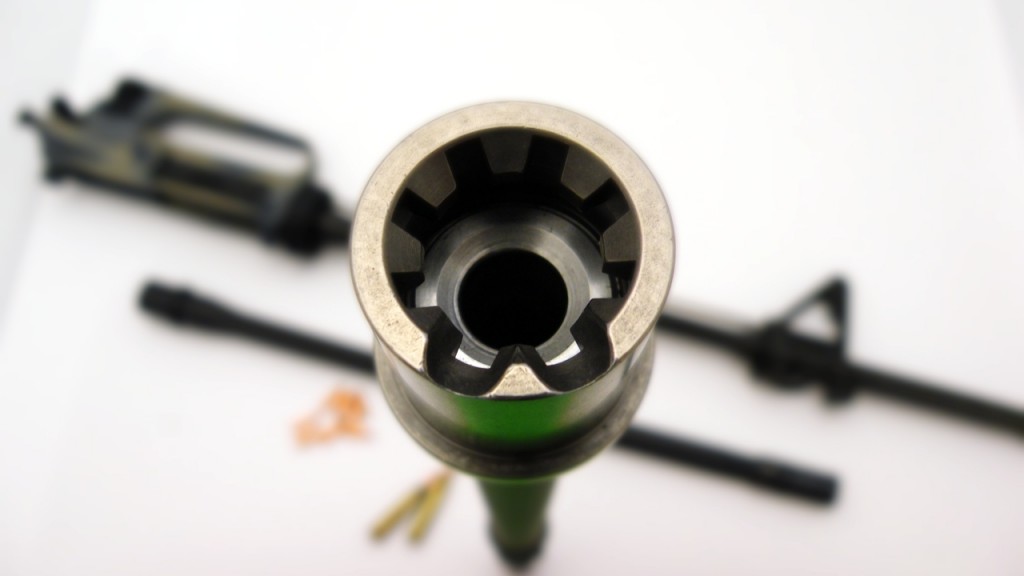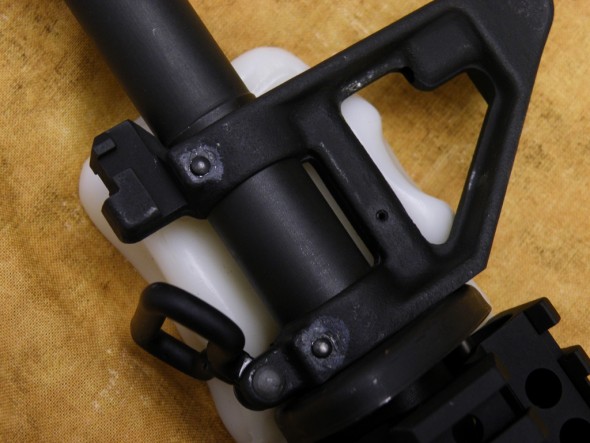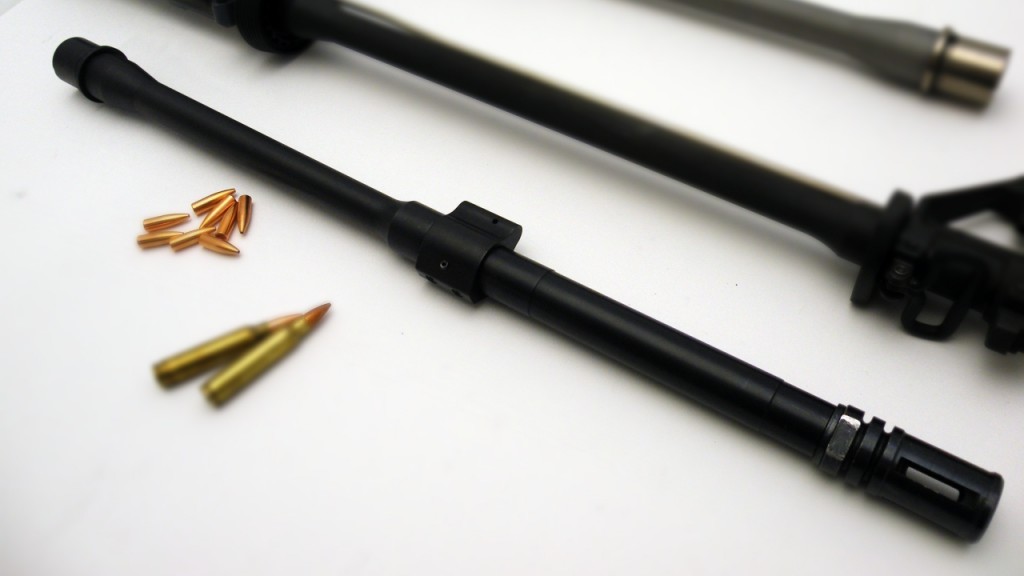It’s a competitive market. Your choice for barrel companies has expanded exponentially since the AWB sunset. Who do you give your money to? We obviously have different shooting goals in mind, but a big part of the popularity of the AR belies its abilities as a do all rifle. The match 16 inch barrel is at home on the target range as it is capable of defending you and your loved ones in times of duress. For a long time the military has required a tough, chrome lined, 5.56 nato chambered rifle to ensure barrel longevity and reliability in combat conditions. For a long time, the civilian market has usurped the capabilities of traditional mil-spec barrels.
Mil Spec Barrels are so Blasé… ?
Let’s break down the problem. The Mil Spec barrel is capable of 1.5-2.0 minutes of angle and is built from tough steel to make sure it survives high volume fire and gives uncle sam a good use out of his money. The problem is that Mil-Spec barrels are not quite pertinent to civilians who may put several thousands down the pipe a year, and almost none in full automatic fire. As a civilian, the quality vs price of mil-spec barrels has been skewed by any number of barrel manufacturers who have produced low-cost, reliable, and very accurate barrels compared to the more expensive “better than mil-spec” cold hammer forged counterparts. Retailing at a whopping $289 for a naked DD barrel, and slapping you in the face at $300 plus dollars for a BCM pipe (with no gas tube, no gas block, nothing) it begs to question weather “mil-spec” or other high-end 5.56 “combat worthy” barrels are actually worth it to the civilian shooter.
Here is a very good test done by MOLON at AR15.com. It highlights a 14.5 inch BCM barrel that retails for around $309 dollars. In this test, we see that the BCM barrel has some interesting groupings in that several shots are tight and touching, while others go wild. It all boils down to a 1.5-2 MOA barrel. People in the thread are taken back by the price for performance. In all honesty, the barrels accuracy is acceptable and certainly meets the militaries specs. Surely you can defend yourself with that barrel, and it’s a CHF barrel from a well respected manufacturer of solid rifles. It’s even capable of hitting a man sized target at 500+ yards. So what’s wrong? The civilian market has given us higher expectations at a lower cost, that’s what’s the matter.

In this current marketplace, you can find many barrel assemblies whose manufacturers guarantee 1 MOA or less in accuracy. In this marketplace, you can find quality barrels from $120 to $235 dollars with gas blocks installed and accuracy performance that meets or exceeds the mil-spec criteria. The question is, are these cheaper barrels “combat” worthy? After all, that’s why you would buy a BCM, because you want a no shit rifle that’s going to work. Right? Don’t we all?
The problem is, as civilians, we follow the mil-spec mantra and have done so for a long time. Now that the war on terror has slowed down, manufacturers have turned towards the civilian markplace by offering very unique, designer components and quality components that are affordable for the working man. We all want a combat ready rifle. The reality is that we won’t be capable of abusing a barrel like the military can. We don’t need 5.56 chambered chrome lined, CHF barrels for a reliable weapon. We have many reliable and accurate barrels chambered in .223 Wylde which is in many ways superior for civilian use over 5.56; it reduces the long throat and lets the projectile engage the rifling sooner and in a more consistent manner. It certainly isn’t mil-spec, but for civilians it’s a smarter choice with accuracy benefits. We also have Melonite which has been part of the drive in reducing barrel costs, yet giving us a very consistent, accurate product with a long barrel life. The game is changing.
If your rifle is stored ready to go, what is the likelihood that in the wildest SHTFantasy that you will be able to shoot out that barrel? In any circumstance where you may use the rifle to defend life and limb (or liberty), what will be more important, having a barrel with a higher degree of accuracy and precision to aid you in hitting your target, or buying a more expensive product that doesn’t deliver the degree of accuracy but promises maybe a few thousand rounds longer life?
If SHTF did come, an accurate rifle and a competent rifleman could make use of that accuracy for not only self-defense at a distance, but that higher degree of accuracy may be the difference between hitting a small object (say a head, a small game animal, whatever) vs missing the target. I figured that if you had to shoot a target, with all your errors and stress from being involved in life or death situation, having an accurate barrel and consistent bullet will be of more aid to you than a less accurate barrel and a ballisticly poor cartridge blown about by the wind and hampered by inaccuracy. If all we see is a target which appears for a brief second, and we put that dot on it and quickly mash that trigger, I hope that not only is lady luck on my side, but that my rifle hit where it aimed, and my projectile not be pushed away by the environment. I don’t want a barrel to let a flyer go wide. I want consistent results from my barrel.
As civilians, the accurate barrels being produced at a lower cost outweigh the benefits of going CHF, Mil-Spec Chrome lined, etc. At the cost of a few thousand rounds of barrel life, we get more usable accuracy without sacrificing reliability, and it can keep costs down. Having an accurate rifle permits us to enjoy a day at the range honing our small target skills as well as permitting us the greatest chance that our bullet will connect both near and at a distance if the time should ever come to use our skills in defense. I realize that the mil-spec barrels can hit a man-sized target, but we all know that men wont stand up in a field waiting to get shot. They will present a very small, mobile target, and we need rifles with the accuracy to dole out hits instead of misses.
Wrapping Up:
Accuracy and reliability can be had at a cheaper price than mil-spec barrels or other “hard use” military style barrels. The civilian marketplace has given us numerous options at a lower cost, and in the grand scheme of things, a civilian with an accurate AR15 has a rifle capable of wider use both as a rifle capable of hitting smaller targets, and as an accurate rifle for throwing rounds down range should he/she know how to use the rifle effectively. We are unlikely, as civilians, to burn out barrels to the point where CHFs long barrel life, will be realized. The benefits of a barrel which may not theoretically last as long, but which offers the shooter greater accuracy would likely be a smarter choice for civilian shooters. In some products, you can have both tight groups and mil-spec chrome lined love, so do your research. These mil-spec barrels will be ideal if the price is right and your research leads you to a good product, but smarter design and lower costs have lead me to jump ship on some of the mil-spec barrel mantra as the AR15 marketplace has evolved.
The AR15 is a do all rifle. Take the best components you can afford and assemble them into a rifle that can, literally, do almost everything well.










When I went to USMC basic at Camp Pendleton in the 1980s, we were told our M16A1 rifles were rated by Colt at 440 meters – this was with a lightweight 20″ barrel, which, if I recall correctly, would have been chrome lined. Yes, we played with full auto, but our Primary Marksmanship Instructors (PMIs) emphasized a philosophy of “one shot, one kill” rather than “spray and pray.” I still believe in this philosophy.
Since my time in the Corps things have changed. My 440 meter M16 has been largely replaced with the M4, whose 16″ barrel is rated at 300 meters accurate range.
Let’s do a little math. The area of a circle is equal to pi times the radius squared. For a 440 meter radius, that works out to about 608,000 square meters of area that can be covered by a man with an M16. For a 300 meter radius, it works out to under 283,000 square meters, or less than half the effective area.
If you’re a soldier fighting from an armored vehicle in the streets of Fallujah, that shortened range may mean little, and the easier handling of the shorter weapon inside the vehicle is probably worth it. If you’re in a SHTF situation without the support of armored vehicles, or indeed an army, that may not be so true.
Also – chrome lining on barrels is generally considered to degrade accuracy slightly, as it adds a few microns of metal plating to the bore. This is a tradeoff for the increased durability under the heat and stress of full-auto fire.
Without the logistical support of an army, and its generous ammo supply, in an SHTF situation I’ll probably need to carry all the ammo I’ve got. That makes every round precious – back to “one shot, one kill” – and my barrel would benefit a lot more from accuracy than from that chrome lining.
So – I’ve built several ARs. I’m currently building a 7.62 to be a thousand meter weapon. But my go-to rifle has a match trigger and an 18″ stainless SPR barrel, in .223 Wylde, by White Oak Armory. It’s rated at 1/2 MOA and 600 meters – that works out to 1,130,000 square meters of covered area – more than twice the effective area of my old USMC M16.
No, it’s not mil-spec, and it doesn’t have full auto. It doesn’t have a chrome lining, and I don’t want one. It’s better than mil-spec.
Until I finish my thousand meter rifle, this is my choice.
Cal doesn’t include numbers for ~2MOA compared to a 1MOA group, but I wonder if it really matters all that much (+- a few percentage points) in the end. Granted, his posted numbers are for 6.5 Creedmoor, but I’m pretty sure the concept is the same.
http://precisionrifleblog.com/2015/04/15/how-much-does-group-size-matter/
Thoughts? Certainly, a tighter grouping barrel is “better” than one that doesn’t perform as well. But by how much? The answer can be quantified.
That’s an excellent article and another point where I have seen WEZ analysis referenced by Mr. Litz. I would like to see that data run through with 5.56 ammo, typical 5.56 ranges, and mil spec accuracy criteria vs the expected accuracy of a sub MOA barrel.
Looks like I will have to save some pennies for that software, so I hope it’s user friendly.
Likely things do become a point of diminishing returns, but i would imagine that if that shot analysis was run through for an AR that we would see benefits of the gold standard “sub MOA” barrel and perhaps they would show enough of a difference to warrent a switch from the old accuracy standards of mil spec barrels to more accurate products. As in, perhaps we should stress a common level of expected accuracy out of a good barrel over spending more money on $300 botique high end military barrel which adds variables into our shooting.
Again I realize you can have both accuracy and better than mil spec attributes, but that comes with a nice bit of coin out of your pocket which puts it out of the reach for many shooters interested in becoming effective with their personal weapon even though it isn’t a high end top tier etc. Etc.
Thank you for posting that link. Serious analysis for shooters concerned with statistically significant attributes and how they play into the grand scheme of things.
That would be great if you got the software and started posting your findings! We can discuss the merits of “1MOA or less barrels” all day long, but I think the software answers a lot of questions definitively. For instance, I would never have guessed that going from 1MOA to .5MOA only helps by 8% with Cal’s given parameters.
I always hate bringing the cost of gear into the equation when discussing this stuff, but it unfortunately is a factor for many of us. In the end though, $100-$200 saved on any given barrel in light of the total cost of ammunition to wear it out (and range fees, traveling, time spent) is pretty insignificant.
sandraiser.com and I took our 5.56 guns out to 750 yards at BOTW near Austin last year. He has an ARPrecision 16″ lightweight, free floated barrel (SS10x for optics). I shot my 14.5 carbine gas BCM, with MOE handguards (Razor HDII 1-6 for optics).
We didn’t notice an appreciable difference in hits on target between the two rifles on 18″x24″ steel at that distance (75 grain Hornady/Varget handloads and Hornady 75 grain steel training factory ammo)
Our ability to call the wind was the limiting factor on that day, to make a hit with either rifle on any of the steel they had set up at 750. We were also shooting from nice concrete benches, which helped quite a bit.
Will his ARP barrel shoot a better group at 100 yards compared to my non-freefloated BCM? Probably. Did it really matter that day? No… I tend to think that group size matters much less than we all tend to think it does. Cal’s post seems to support that.
That experience was enough to convince me to just shoot the BCM with good ammo, and be happy. Great post, raises some great questions.
I may agree with some points in this article but a few points really make no common sense.
For example, “I realize the mil-spec barrels can hit a man-size target..” Well, actually mil-spec barrels can hit much smaller targets than that.
But then you continue.. “but we all know that men won’t stand up in the field waiting to get shot.” … this insinuates that a mil-spec barrel can’t hit anything in the theatre unless its standing in a field waiting to get shot. The premise for many of your points fail the logic test. Not that I’m disagreeing with the overall point of utilizing modern technology outside of the mil-spec box. Simply “be prepared” and having a mil-spec AR is a great idea for situations that we all hope never happen and probably won’t. Last time out I hit a license plate at 300 yards with a mil-spec barrel and a red dot. I know it wasn’t moving. I’m just saying.
I have a Colt m4a1 with a trijicon ta31rco and a 14.5 inch barrel.I shoot out to 400 meters and hit milk jugs filled with water.I like the accuracy but think that the ability to stay in a fight is more important.Reliability > accuracy in firefight.
My colt blue label Comp 6700 hits milk jugs at 400 with 57 year old eyes and open sights , shes a keeper
I know this is a REALLY OLD article but here goes. All of my AR’s have 20 inch chrome lined barrels. The barrels include a BCM .gov profile 5.56 NATO, a chrome lined hybrid profile 20 inch criterion, and a 20 inch chrome lined hybrid profile 308. They all have free floated barrels because I hate timing barrel nuts. The worst shooting one in the bunch (the BCM) will put 10 shots under a quarter at 100 yards from a clean cold bore. When its hot and filthy, its a 2 moa gun. So for practicality’s sake I consider my BCM a 2 minute rifle. Thats ok because CONSISTENT 2 MOA performance is good enough to hit a kevlar helmet at 400 yards.
My other two rifles are CONSTANT sub moa shooters because they have match quality barrels, two stage triggers, and optics meant for target shooting.
The point of my response that if you pick the right chrome lined barrel you can have the best of both worlds.
Milspec was never intended to get up to average. With 24/7 maintenance/armory support, milspec was designed to the lowest standards possible with a go bang most of the time bar height.